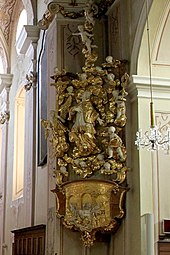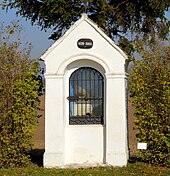Parish church Kirchberg am Wagram
The Roman Catholic parish church in Kirchberg am Wagram (also pilgrimage church Maria Trost ) in the Lower Austrian district of Tulln is dedicated to St. Dedicated to Stephan . Kirchberg belongs to the Hadersdorf deanery in the vicariate Unter dem Manhartsberg of the Archdiocese of Vienna . The Gothic staggered building from the second half of the 14th century, which was extensively baroque in the 18th century and restored in 1959/60, rises from a natural fortification, the so-called Kirchberg, southeast of the market square. The church is a listed building .
history
The parish of Kirchberg is documented from the year 1147. The church was consecrated again in 1726 and was incorporated into the Passau cathedral chapter until 1803 . Today it belongs to the Archdiocese of Vienna .
- Pilgrimages
On the occasion of the birth of his son , the businessman Christoph Beer donated a statue of the Madonna in 1679 at the point between Kirchberg and Mitterstockstall , where the so-called original chapel stands today. The farmer Lorenz Höck later built a chapel around this statue as a thank you for his recovery from a serious illness, which over time was enlarged to become a Maria-Trost church and a popular pilgrimage destination. In 1787, as part of the Josephine reforms , this church was demolished. Parts of the facility, the statue of the Virgin Mary and the stone column were moved to the parish church of St. Stephan. Despite the Josephine restrictions, processions to the statue of the Madonna were reported again in 1823. St. Stephan had taken over the function as a pilgrimage church.
The Kirchberg merchant Ignaz Berger (1787–1870) had a cross erected on the site of the demolished church in 1832. This was later walled and is now called the original chapel. The chapel is often included in parish and deanery events.
Exterior construction
The nave with a slightly raised central nave , corner struts and lunette windows dates from the first half of the 18th century in its current form. On the west side there is a baroque vestibule in front of a high Gothic portal from the second half of the 14th century, with a pointed arched reveal . The rectangular , pilaster- shaped choir with high segmented arched windows and a bricked-up tracery window exposed in 1956 is the same height as the central nave and only slightly narrower. The northeast tower, which is essentially medieval and has a square floor plan , was built in the 14th century. It has small, Gothic pointed arched windows on the north side. In the two upper zones, it has been given a Baroque style and is provided with oval hatches and rounded arched acoustic windows with curved roofs. The tower is crowned by an onion helmet made in 1755 , which was restored in 1929. The north-eastern stair tower with small three-pass windows from the 14th century has a baroque bell helmet. In the tympanum of the north porch with wicker arch portal one is stucco medallion of Maria Zeller Madonna delle Grazie to see. The gravestone of Pastor Ignaz Schweiger († 1835) is one of the other features of the exterior .
inner space
The nave has three naves and four yokes . There are oblong yokes in the high central nave. During the Baroque renovation in 1726, a new vaulting was carried out with a needle cap barrel between strong belt arches and the Gothic pillars were redesigned with pilasters with Ionic capitals and fighters that were placed on all sides . Flat-arched pillar arcades lead to the side aisles . Above that, there are blendoratories with segmental arch openings and balustrades . The side aisles have longitudinal oblong, groin vaulted yokes between belts, which are each extended in the east by a rectangular chapel yoke with a round arched passage to the choir. The three-part, flat-arched organ loft is arched under a stitch cap in the area of the central nave and groin arched on the sides. The slightly raised and recessed choir with a rounded end is arched and structured according to the nave and has oratorios with segmental arch openings. The sacristy in the north has a flat ceiling , while the south sacristy has a groin vault.
The decorative paintings in the nave and choir were made by Josef Klenkhart in 1906 and 1910. The stained glass Heart of Jesus , Our Lady of Sorrows , Good Samaritan , Jesus with Warrior and Christ and Magdalena are marked 1919; a portrait of St. Cecilia dates from 1888.
Facility


The baroque high altar with a column structure made of stucco marble and a volute top has an altar leaf stoning of St. Stephen , inscribed with CI Carlone from 1712, an oval top picture of God the Father surrounded by angels and side figures of Saints Peter and Paul . A baroque tabernacle with angel figures on the side of the cafeteria is crowned by putti . Behind the tabernacle there is a statue of grace, donated in 1674, on the column from the Mitterstockstall pilgrimage chapel, which was repealed in 1783. In the north chapel there is a side altar renovated in 1756 with a baroque column structure and baroque side figures of Saints Francis of Assisi and Clara , which instead of the original altar sheet bears a portrait of the Sacred Heart of Jesus by Wilhelm Russ from 1912. The side altar of the south chapel is characterized by a baroque altar structure made of stucco marble. In the central niche is a copy of a Gothic Madonna figure from around 1420, the original of which is kept in the Vienna Diocesan Museum. Side figures represent the Saints Dominic and Catherine of Siena . Two corresponding baroque wall altars are attached to the two aisle walls in the east. The left altar sheet Maria Immaculata is inscribed with Martin Johann Schmidt 1771 and is accompanied by side figures of Saints Catherine and Barbara . The right altar panel depicts Saint Rosalia , is labeled Johann Georg Schmidt , 1725 and has side figures of the holy brothers Cosmas and Damian as well as a stipes shrine with a reclining figure of Saint Rosalia. In the west of the south aisle wall there is another, late Baroque side altar with volute top, altar sheet of the Holy Family from around 1771 and probably from the Paul Troger school as well as side figures of Saints Joachim and Anna .
The late Baroque pulpit dates from the middle of the 18th century, with richly carved decorations, reliefs of the Whitsun miracle and Daniel in the lions' den , figures of faith, hope, love on the bell cover and allegories of the church and synagogue. A late baroque blind pulpit is decorated with reliefs of St. John Nepomuk . Ignaz Gatto's organ dates from 1781. Figures of Saints Leopold and Karl Borromeo go back to the second half of the 18th century . Further furnishings include a crucifix from the first half of the 18th century, a relief Baptism of Christ from the mid-18th century in a rococo frame , two former altar leaves on canvas with images of Saints Wendelin and Florian, inscribed Martin Johann Schmidt, 1771 , two Pictures of Saints Anthony of Padua and Aloysius from the first half of the 19th century, pictures of the Stations of the Cross from the second half of the 18th century, baroque baptismal fonts with shell basins from the first half of the 18th century in the vestibule, a baptismal font made of red marble in Gothic shapes with a copper lid from the 20th century, a baroque choir stalls from the first half of the 18th century and rococo sacristy cupboards from the middle of the 18th century.
The church also has several tombstones and tombstones: in the north aisle, the tombstone of Pastor Ulrich and his parents Gerung and Eteolda with incised medallions of the deceased and the Lamb of God and Gothic inscription; in the western vestibule the marble tombstone of pastor Hans Hippelsdorfer († 1405) with relief and Gothic minuscule inscription ; Grave slabs of Clara Beer († 1710), Justus Pfall († 1702) and Bartholomäus Zaller († 1715).
Bells
The bell of the church consists of four bells, the oldest of which was cast by Josef Scheichel ( Scheichel bell foundry ) in 1782. It weighs 282 kg with a diameter of 75 cm. The other bells are from 1949 by the Bell Foundry in Pfundner .
literature
- DEHIO Lower Austria north of the Danube . Berger, Vienna 2010, ISBN 978-3-85028-395-3 , pp. 499-501.
Web links
- Description of the Church on the Parish Association's website; accessed February 16, 2012
Individual evidence
- ↑ pilgrimages. In: Website of the parish association Kirchberg am Wagram. Retrieved February 16, 2012 .
- ^ History of the parish of St. Stephan
- ^ Pilgrimage Church of Maria Trost. In: bergfex.at. Retrieved February 16, 2012 .
- ^ Pilgrimage Church of Maria Trost. (No longer available online.) In: Website of the Kirchberg am Wagram community. Formerly in the original ; Retrieved February 16, 2012 . ( Page no longer available , search in web archives ) Info: The link was automatically marked as defective. Please check the link according to the instructions and then remove this notice.
- ↑ Original chapel on marterl.at
- ↑ The bells of the parish church Kirchberg am Wagram (local history region Kirchberg am Wagram)
- ↑ YouTube video: The peal of the parish church in Kirchberg am Wagram
Coordinates: 48 ° 25 ′ 57.9 ″ N , 15 ° 54 ′ 0.1 ″ E



